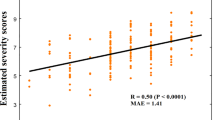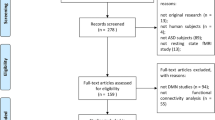Abstract
Autism spectrum disorder (ASD) is a group of neurodevelopmental disorders. Brain mapping has shown that functional brain connections are altered in autism. This study investigated the pattern of brain connection changes in autistic people compared to healthy people. This study aimed to analyze functional abnormalities within the brain due to ASD, using resting-state functional magnetic resonance imaging (fMRI). Resting-state functional magnetic resonance images of 26 individuals with ASD and 26 healthy controls were obtained from the Autism Brain Imaging Data Exchange (ABIDE) database. The DPARSF (data processing assistant for resting-state fMRI) toolbox was used for resting-state functional image processing, and features related to functional connections were extracted from these images. Then, the extracted features from both groups were compared using an Independent Two-Sample T Test, and the features with significant differences between the two groups were identified. Compared with healthy controls, individuals with ASD showed hyper-connectivity in the frontal lobe, anterior cingulum, parahippocampal, left precuneus, angular, caudate, superior temporal, and left pallidum, as well as hypo-connectivity in the precentral, left superior frontal, left middle orbitofrontal, right amygdala, and left posterior cingulum. Our findings show that abnormal functional connectivity exists in patients with ASD. This study makes an important advancement in our understanding of the abnormal neurocircuits causing autism.




Similar content being viewed by others
References
Croen LA, et al. The changing prevalence of autism in California. J Autism Dev Disord. 2002;32(3):207–15.
Asuero AG, Sayago A, González A. The correlation coefficient: an overview. Crit Rev Anal Chem. 2006;36(1):41–59.
Faraj R, Zare H. Evaluation of white matter tracts in autistic individuals: a review of diffusion tensor imaging studies. SSU J. 2021;29(3):3539–55.
Correa N, Adalı T, Calhoun VD. Performance of blind source separation algorithms for fMRI analysis using a group ICA method. Magn Reson Imag. 2007;25(5):684–94.
Villalobos ME, et al. Reduced functional connectivity between V1 and inferior frontal cortex associated with visuomotor performance in autism. Neuroimage. 2005;25(3):916–25.
Welchew DE, et al. Functional disconnectivity of the medial temporal lobe in Asperger’s syndrome. Biol Psychiat. 2005;57(9):991–8.
Kana RK, et al. Sentence comprehension in autism: thinking in pictures with decreased functional connectivity. Brain. 2006;129(9):2484–93.
Just MA, et al. Functional and anatomical cortical underconnectivity in autism: evidence from an FMRI study of an executive function task and corpus callosum morphometry. Cereb Cortex. 2007;17(4):951–61.
Kleinhans NM, et al. Abnormal functional connectivity in autism spectrum disorders during face processing. Brain. 2008;131(4):1000–12.
Koshino H, et al. fMRI investigation of working memory for faces in autism: visual coding and underconnectivity with frontal areas. Cereb Cortex. 2008;18(2):289–300.
Mizuno A, et al. Partially enhanced thalamocortical functional connectivity in autism. Brain Res. 2006;1104(1):160–74.
Turner S, et al. Heritability of post-mixing aggressiveness in grower-stage pigs and its relationship with production traits. Anim Sci. 2006;82(5):615–20.
Raichle ME, Snyder AZ. A default mode of brain function: a brief history of an evolving idea. Neuroimage. 2007;37(4):1083–90.
Just MA, et al. Cortical activation and synchronization during sentence comprehension in high-functioning autism: evidence of underconnectivity. Brain. 2004;127(8):1811–21.
Cherkassky VL, et al. Functional connectivity in a baseline resting-state network in autism. NeuroReport. 2006;17(16):1687–90.
Kennedy DP, Courchesne E. The intrinsic functional organization of the brain is altered in autism. Neuroimage. 2008;39(4):1877–85.
Monk CS, et al. Neural circuitry of emotional face processing in autism spectrum disorders. J Psychiat Neurosci JPN. 2010;35(2):105.
Weng S-J, et al. Alterations of resting state functional connectivity in the default network in adolescents with autism spectrum disorders. Brain Res. 2010;1313:202–14.
Assaf M, et al. Abnormal functional connectivity of default mode sub-networks in autism spectrum disorder patients. Neuroimage. 2010;53(1):247–56.
Dinstein I, et al. Disrupted neural synchronization in toddlers with autism. Neuron. 2011;70(6):1218–25.
Weng SJ, et al. Neural activation to emotional faces in adolescents with autism spectrum disorders. J Child Psychol Psychiatry. 2011;52(3):296–305.
von dem Hagen EA, et al. Reduced functional connectivity within and between ‘social’ resting state networks in autism spectrum conditions. Soc Cogn Affect Neurosci. 2013;8(6):694–701.
Itahashi T, et al. Altered network topologies and hub organization in adults with autism: a resting-state fMRI study. PLoS ONE. 2014;9(4):e94115.
Alaerts K, Swinnen SP, Wenderoth N. Sex differences in autism: a resting-state fMRI investigation of functional brain connectivity in males and females. Soc Cogn Affect Neurosci. 2016;11(6):1002–16.
Rudie JD, et al. Altered functional and structural brain network organization in autism. NeuroImage Clin. 2013;2:79–94.
Hernandez LM, et al. Neural signatures of autism spectrum disorders: insights into brain network dynamics. Neuropsychopharmacology. 2015;40(1):171–89.
Maximo JO, Cadena EJ, Kana RK. The implications of brain connectivity in the neuropsychology of autism. Neuropsychol Rev. 2014;24(1):16–31.
Washington SD, et al. Dysmaturation of the default mode network in autism. Hum Brain Mapp. 2014;35(4):1284–96.
Yan L, et al. Physiological origin of low-frequency drift in blood oxygen level dependent (BOLD) functional magnetic resonance imaging (fMRI). Magn Res Med Off J Intern Soc Magn Res Med. 2009;61(4):819–27.
Stanley ML, et al. Defining nodes in complex brain networks. Front Comput Neurosci. 2013;7:169.
Redcay E, et al. Intrinsic functional network organization in high-functioning adolescents with autism spectrum disorder. Front Hum Neurosci. 2013;7:573.
Müller R-A, et al. Underconnected, but how? A survey of functional connectivity MRI studies in autism spectrum disorders. Cereb Cortex. 2011;21(10):2233–43.
Alaerts K, et al. Age-related changes in intrinsic function of the superior temporal sulcus in autism spectrum disorders. Soc Cogn Affect Neurosci. 2015;10(10):1413–23.
Cheng W, et al. Autism: reduced connectivity between cortical areas involved in face expression, theory of mind, and the sense of self. Brain. 2015;138(5):1382–93.
Hahamy A, Behrmann M, Malach R. The idiosyncratic brain: distortion of spontaneous connectivity patterns in autism spectrum disorder. Nat Neurosci. 2015;18(2):302–9.
Ha S, et al. Characteristics of brains in autism spectrum disorder: structure, function and connectivity across the lifespan. Exp Neurobiol. 2015;24(4):273.
Monk CS, et al. Abnormalities of intrinsic functional connectivity in autism spectrum disorders. Neuroimage. 2009;47(2):764–72.
Wiggins JL, et al. Using a self-organizing map algorithm to detect age-related changes in functional connectivity during rest in autism spectrum disorders. Brain Res. 2011;1380:187–97.
Gotts SJ, et al. Fractionation of social brain circuits in autism spectrum disorders. Brain. 2012;135(9):2711–25.
Sadeghi M, et al. Screening of autism based on task-free fmri using graph theoretical approach. Psychiat Res Neuroimag. 2017;263:48–56.
Ibrahim K, et al. Reduced amygdala–prefrontal functional connectivity in children with autism spectrum disorder and co-occurring disruptive behavior. Biolog Psychiat Cogn Neurosci Neuroimag. 2019;4(12):1031–41.
Guo X, et al. Decreased amygdala functional connectivity in adolescents with autism: a resting-state fMRI study. Psychiat Res Neuroimag. 2016;257:47–56.
Barad M, Gean P-W, Lutz B. The role of the amygdala in the extinction of conditioned fear. Biol Psychiat. 2006;60(4):322–8.
Courchesne E, Pierce K. Why the frontal cortex in autism might be talking only to itself: local over-connectivity but long-distance disconnection. Curr Opin Neurobiol. 2005;15(2):225–30.
Keown CL, et al. Local functional overconnectivity in posterior brain regions is associated with symptom severity in autism spectrum disorders. Cell Rep. 2013;5(3):567–72.
Cerliani L, et al. Increased functional connectivity between subcortical and cortical resting-state networks in autism spectrum disorder. JAMA Psychiat. 2015;72(8):767–77.
Chien HY, et al. Hyperconnectivity of the right posterior temporo-parietal junction predicts social difficulties in boys with autism spectrum disorder. Autism Res. 2015;8(4):427–41.
Delmonte S, et al. Functional and structural connectivity of frontostriatal circuitry in Autism spectrum disorder. Front Hum Neurosci. 2013;7:430.
Devinsky O, Morrell MJ, Vogt BA. Contributions of anterior cingulate cortex to behaviour. Brain. 1995;118(1):279–306.
Frey S, et al. Dissociating the human language pathways with high angular resolution diffusion fiber tractography. J Neurosci. 2008;28(45):11435–44.
Insel TR. Toward a neuroanatomy of obsessive-compulsive disorder. Archives of general psychiatry. 1992 Sep 1;49(9):739–44.
O’Dwyer L, et al. Decreased left caudate volume is associated with increased severity of autistic-like symptoms in a cohort of ADHD patients and their unaffected siblings. PLoS ONE. 2016;11(11):e0165620.
Khadem-Reza ZK, Zare H. Automatic detection of autism spectrum disorder (ASD) in children using structural magnetic resonance imaging with machine vision system. Middle East Curr Psychiat. 2022;29(1):1–7.
Khadem-Reza ZK, Zare H. Evaluation of brain structure abnormalities in children with autism spectrum disorder (ASD) using structural magnetic resonance imaging. Egypt J Neurol Psychiat Neurosurg. 2022;58(1):1–4.
Acknowledgements
This study was conducted using the MSc. thesis of Medical Physics. The authors would like to thank the Research Deputy of MUMS for the financial support of this project (No. 980858). Ethics code: IR.MUMS.MEDICAL.REC.1398.717)
Author information
Authors and Affiliations
Corresponding author
Ethics declarations
Conflict of interest
The authors declare that they have no competing interests.
Research involving human participants and/or animals
Not applicable.
Informed consent
Not applicable.
Additional information
Publisher's Note
Springer Nature remains neutral with regard to jurisdictional claims in published maps and institutional affiliations.
About this article
Cite this article
Khandan Khadem-Reza, Z., Shahram, M.A. & Zare, H. Altered resting-state functional connectivity of the brain in children with autism spectrum disorder. Radiol Phys Technol 16, 284–291 (2023). https://doi.org/10.1007/s12194-023-00717-2
Received:
Revised:
Accepted:
Published:
Issue Date:
DOI: https://doi.org/10.1007/s12194-023-00717-2




